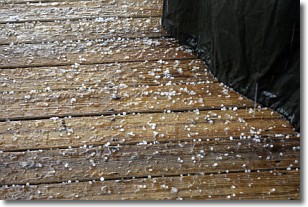Weather Alert in Texas
Hydrologic Outlook issued May 28 at 3:50PM CDT by NWS Brownsville TX
AREAS AFFECTED: Brooks, TX
DESCRIPTION: ESFBRO The Brownsville Texas National Weather Service Office has implemented Advanced Hydrologic Prediction Service (AHPS) for the Los Olmos Creek basin in Deep South Texas. AHPS enables the National Weather Service to provide long-range probabilistic outlooks. This service is also available on the internet. In the table below...the 90 through 10 percent columns indicate the chance the creek could rise above the listed stage levels in the next 90 days. Example: The Los Olmos Creek near Falfurrias has a flood stage of 11 feet. There is a 50 percent chance the Falfurrias forecast point will rise above 2.3 feet during the next 90 days. Chance of Exceeding Stages at Specific Locations Valid [05/28/2025 - 08/26/2025] Location FS(FT) 90% 80% 70% 60% 50% 40% 30% 20% 10% -------- ----- --- --- --- --- --- --- --- --- --- Los Olmos Creek Falfurrias 11.0 1.8 1.8 1.8 2.0 2.3 2.4 3.1 3.9 5.4 This long-range probabilistic outlook contains numbers that are calculated using multiple scenarios from 50 years of historical climatological and stream flow data. These numbers also take into account current conditions of the creek and soil moisture. By providing the complete range of probabilistic numbers...the level of risk associated with the long-range planning decisions can be determined. Additional supportive data and explanation are available on the internet at: http://water.weather.gov/ahps2/long_range.php?wfo=bro Long range probabilistic outlooks are issued by the third Thursday of every month. Outlooks may be issued more than once a month.
INSTRUCTION: N/A
Want more detail? Get the Complete 7 Day and Night Detailed Forecast!
Current U.S. National Radar--Current
The Current National Weather Radar is shown below with a UTC Time (subtract 5 hours from UTC to get Eastern Time).

National Weather Forecast--Current
The Current National Weather Forecast and National Weather Map are shown below.

National Weather Forecast for Tomorrow
Tomorrow National Weather Forecast and Tomorrow National Weather Map are show below.

North America Water Vapor (Moisture)
This map shows recent moisture content over North America. Bright and colored areas show high moisture (ie, clouds); brown indicates very little moisture present; black indicates no moisture.

Weather Topic: What is Rain?
Home - Education - Precipitation - Rain
 Next Topic: Shelf Clouds
Next Topic: Shelf Clouds
Precipitation in the form of water droplets is called rain.
Rain generally has a tendency to fall with less intensity over a greater period
of time, and when rainfall is more severe it is usually less sustained.
Rain is the most common form of precipitation and happens with greater frequency
depending on the season and regional influences. Cities have been shown to have
an observable effect on rainfall, due to an effect called the urban heat island.
Compared to upwind, monthly rainfall between twenty and forty miles downwind of
cities is 30% greater.
Next Topic: Shelf Clouds
Weather Topic: What is Sleet?
Home - Education - Precipitation - Sleet
 Next Topic: Snow
Next Topic: Snow
Sleet is a form of precipitation in which small ice pellets are the primary
components. These ice pellets are smaller and more translucent than hailstones,
and harder than graupel. Sleet is caused by specific atmospheric conditions and
therefore typically doesn't last for extended periods of time.
The condition which leads to sleet formation requires a warmer body of air to be
wedged in between two sub-freezing bodies of air. When snow falls through a warmer
layer of air it melts, and as it falls through the next sub-freezing body of air
it freezes again, forming ice pellets known as sleet. In some cases, water
droplets don't have time to freeze before reaching the surface and the result is
freezing rain.
Next Topic: Snow
Current conditions powered by WeatherAPI.com




